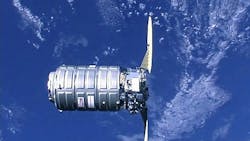Northrop Grumman's Cygnus makes safe arrival at International Space Station
Cygnus launched aboard a Northrop Grumman Antares rocket Wednesday from the Mid-Atlantic Regional Spaceport on Wallops Island, Virginia. As the spacecraft approached the space station, Cygnus executed a series of thruster burns to raise its orbit. Once the spacecraft was in close range, crew members on board the space station grappled the spacecraft with the station’s robotic arm at 5:30 a.m. EDT. Cygnus was then guided to its berthing port on the nadir side of the station’s Unity module and officially installed on to the space station at 7:31 a.m. EDT.
Cygnus arrived at the space station with nearly 7,600 pounds of cargo, supplies and scientific experiments.
Once Cygnus departs the station, the spacecraft will begin a secondary mission to deploy CubeSats for two commercial customers. Cygnus will reposition to deploy three CubeSats using a NanoRacks deployer in the Company’s seventh commercial mission. The Slingshot CubeSat Deployer system is also on board and marking its second mission on a Cygnus spacecraft. Slingshot is a flexible platform that can fly hosted payloads and CubeSats. The system is scheduled to be installed by astronauts while Cygnus is docked to the station in preparation for another round of CubeSat deployments during the next phase of its mission.
After the CubeSats are deployed, Cygnus will remain in orbit for an extended duration mission, an achievement marking a “first” for the spacecraft as it demonstrates capabilities beyond cargo supply and disposal. This newest innovation showcases Cygnus as a future testbed for various types of hosted payload missions. Upon completion of its secondary missions, Cygnus will perform a safe, destructive reentry into Earth’s atmosphere over the Pacific Ocean.
Ready to make a purchase? Search the Intelligent Aerospace Buyer's Guide for companies, new products, press releases, and videos
